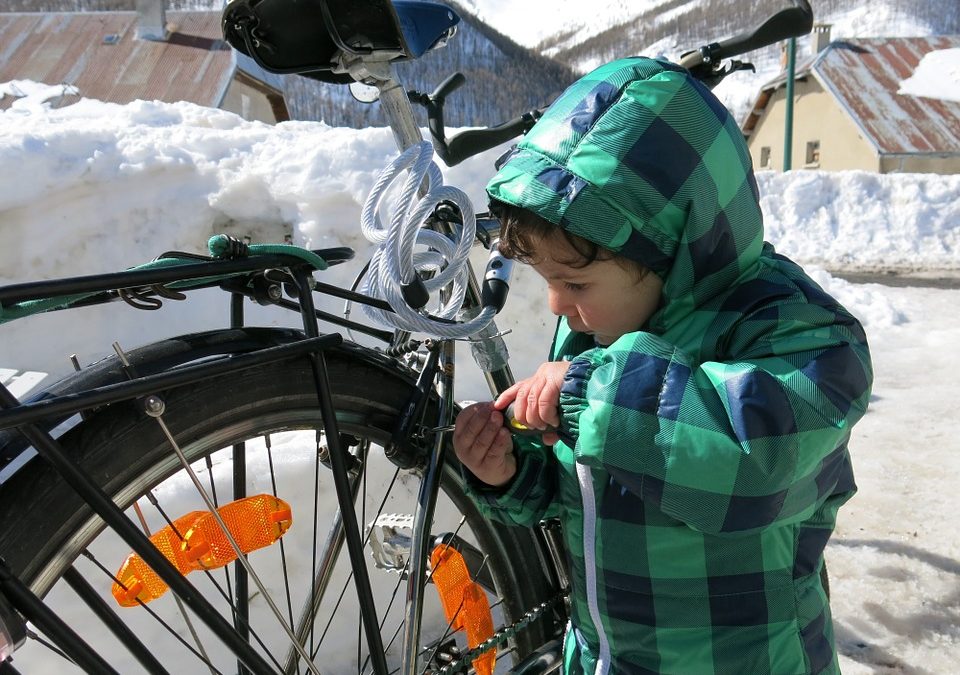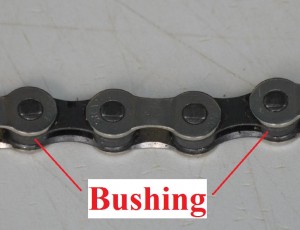It’s as simple as remembering “ABC Quick Check“.
“ABC Quick Check” is used by bike mechanics worldwide to ensure a bike meets basic safety requirements. Perfection can wait when we’re hankering for the first exposed-face ride of the year!
Some helpful home mechanic tools that you may need are:
- Floor Pump
- Adjustable wrench
- Hex keys/ “Allen keys”
- Screwdrivers
A: Air
Riding with too little air – or none at all – isn’t fun, and can permanently damage a tire and the tube inside. Contrary to popular belief, you can’t actually tell if the tire pressure is good by feeling the tire. By the time a tire feels soft, it’s already dangerously low.
Simple floor pumps are inexpensive and a major time saver for home mechanics, compared to pumping your tire up at a local gas station or bike shop. If you do decide to use a gas station air pump, fill your tires in quick bursts, as those machines can easily pop a bike tire.
Check for leaks: You can take a risk and pump up your tires to hope for the best, but it’s always possible your tires won’t hold air and you’ll get stranded somewhere, so it’s good practice to check for leaks first. Every tire will have a recommended pressure minimum and maximum written on the side of it, and a floor pump will have a gauge to tell you what the tire pressure is. Before anything else, you should make sure your tires have no leaks, so just pump them up to the minimum. Check pressure a few hours later to see if it’s dropped- if so, you have a leak on your hands!
- Leak? Removing a tube and patching it can be tricky if you haven’t done it before, but is a skill that most people riding will need at some point. Better to learn at home than have a roadside problem!
- No leaks? Great! Pump up the pressure to where you want it to be, somewhere between the minimum and maximum. Low pressures tend to absorb rough surfaces better, making your ride more comfortable, but higher pressures allow the bike to move faster on smooth surfaces. If you have a floor pump, you can play with the pressure to find what you like best! If you prefer not to, many bikes will have standard automotive valves, and can be filled at the local gas station (in little bursts! You could pop a tire of not careful!).
B: Brakes
Safe brakes are crucial, for obvious reasons! To test them, squeeze your brake levers tight, making sure they don’t touch the handlebar. If they do, chances are your brakes won’t be effective when you need them most. Once you troubleshoot that, take a test ride on a quiet street to make sure they’re doing their job, and that there’s no rubbing, sticking, or squeaking!
If your brakes need more attention, check out Park Tool tutorials for rim brakes (located near the outside of the wheel) and disc brakes (located near the centre of the wheel).
- Note for older bikes: Many bikes from the 80s or before came with steel rims. If you have steel rims, a magnet will stick to them. Steel rims are generally poor at braking the bike, and are dangerously ineffective when wet. If you have steel rims, consider upgrading to aluminum rims, which are lighter, rust-free, and brake much better! These are often available at local community bike shops, and is one of the easiest and cheapest upgrades for older bikes.
- Note for coaster, “backpedal” or fixed-gear bikes. On some bikes, there are no brake levers, and braking is done by pedalling backwards. These brakes are most often found on kids bikes, vintage bikes, and European-style bikes. If pedalling backwards is your bike’s only way of braking, it is crucial that your chain is tight. If your chain falls off, you will have no brakes at all. For anything but super-slow kids bikes, we strongly recommend that you install a second brake for worry-free riding. Your local bike shop can help.
C: Chain
Is your chain rusty? Add a bit of chain lube on each “bushing” (one drop per link is enough!). There are different lubes for different riding conditions, with each one having pros and cons. The thick, sticky ones collect dirt quicker, while the thin, watery ones wash away when wet. The important thing is your chain has lube! New chain-lubers can find assistance here.
“Quick” (Quick Releases)
Quick release levers are on many bikes, and make for fast removal of either wheel or the seatpost. Too often, these are looser than they should be!
- Loosen the lever by flipping it 180 degrees. It should take a lot of force! When closing it again, it should take a lot of palm pressure. If unsure about your quick releases, check out this 5-minute video!
- Note: quick releases make it easier for you to remove certain parts of your bike, but this can make your bike a target for thieves, particularly if you only use one lock. For extra security, ask your local bike shop for a kit to turn your quick-release wheel into a bolt-on wheel, which means potential thieves will have to at least use tools to remove a wheel from your bike.
“Check” (The rest of the bike)
- Grab each tire and try to wobble it. Are they attached firmly to the bike?
- Give each wheel a spin to make sure it spins straight, not scraping anything
- Inspect each wheel for broken and loose spokes
- Grab each pedal and push it in and out, making sure they don’t wobble from looseness.
- Sit on the bike, pull the brakes and push and pull the handlebar. Does it feel loose?
- Grab and shake any accessories attached to the bike, like baskets, rear racks, bells, or bottle cages. Do any bolts or screws need tightening?
That’s your basic ABC Quick Check! Now get out and ride.
Need more help?
No problem! There are a couple of options:
- DIY with Online resources. There are plenty linked to throughout this blog! Most now have videos, making it easier than ever to learn and after you buy the tools, you’ll be able to conveniently do your basic repairs at home! A good starting point is Park Tools Repair Help.
- DIY with a book. Some people just prefer paper, and that’s great. Check out your local bike shop and see what they recommend, just make sure the book applies to the type of bike you have! Some are targeted towards common repairs for either road or mountain bikes.
- Visit a community bike shop. Community bike shops are different from local bike shops in that they provide space and tools for people to fix their own bikes, rather than being a paid service. Winnipeg has many community bike shops that can help you fix your bike and offer some quality recycled parts for cheap. See the list here. Does your community have a shop we aren’t aware of? Send us a message!
- Head to your local bike shop if you’re short on time and just want someone to look at it for you. Winnipeggers have a few shops to choose from.
Need more help?
No problem! There are a couple of options:
- DIY with Online resources. There are plenty linked to throughout this blog! Most now have videos, making it easier than ever to learn and after you buy the tools, you’ll be able to conveniently do your basic repairs at home! A good starting point is Park Tools Repair Help.
- DIY with a book. Some people just prefer paper, and that’s great. Check out your local bike shop and see what they recommend, just make sure the book applies to the type of bike you have! Some are targeted towards common repairs for either road or mountain bikes.
- Visit a community bike shop. Community bike shops are different from local bike shops in that they provide space and tools for people to fix their own bikes, rather than being a paid service. Winnipeg has many community bike shops that can help you fix your bike and offer some quality recycled parts for cheap. See the list here. Does your community have a shop we aren’t aware of? Send us a message!
- Head to your local bike shop if you’re short on time and just want someone to look at it for you. Winnipeggers have a few shops to choose from.





Lots of great information. Thanks!